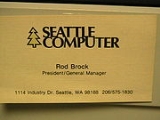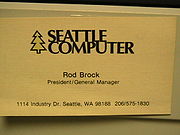
Seattle Computer Products
Encyclopedia

Microcomputer
A microcomputer is a computer with a microprocessor as its central processing unit. They are physically small compared to mainframe and minicomputers...
hardware company which was one of the first manufacturers of computer systems based on the 16-bit
16-bit
-16-bit architecture:The HP BPC, introduced in 1975, was the world's first 16-bit microprocessor. Prominent 16-bit processors include the PDP-11, Intel 8086, Intel 80286 and the WDC 65C816. The Intel 8088 was program-compatible with the Intel 8086, and was 16-bit in that its registers were 16...
Intel 8086
Intel 8086
The 8086 is a 16-bit microprocessor chip designed by Intel between early 1976 and mid-1978, when it was released. The 8086 gave rise to the x86 architecture of Intel's future processors...
processor
Central processing unit
The central processing unit is the portion of a computer system that carries out the instructions of a computer program, to perform the basic arithmetical, logical, and input/output operations of the system. The CPU plays a role somewhat analogous to the brain in the computer. The term has been in...
. SCP began shipping its first S-100 bus
S-100 bus
The S-100 bus or Altair bus, IEEE696-1983 , was an early computer bus designed in 1974 as a part of the Altair 8800, generally considered today to be the first personal computer...
8086 CPU boards to customers in November, 1979, about 21 months before IBM
IBM
International Business Machines Corporation or IBM is an American multinational technology and consulting corporation headquartered in Armonk, New York, United States. IBM manufactures and sells computer hardware and software, and it offers infrastructure, hosting and consulting services in areas...
introduced its Personal Computer which was based on the slower 8088
Intel 8088
The Intel 8088 microprocessor was a variant of the Intel 8086 and was introduced on July 1, 1979. It had an 8-bit external data bus instead of the 16-bit bus of the 8086. The 16-bit registers and the one megabyte address range were unchanged, however...
and introduced the 8-bit ISA bus. SCP shipped an operating system
Operating system
An operating system is a set of programs that manage computer hardware resources and provide common services for application software. The operating system is the most important type of system software in a computer system...
for that hardware about a year before the release of the PC, which was modified by Microsoft
Microsoft
Microsoft Corporation is an American public multinational corporation headquartered in Redmond, Washington, USA that develops, manufactures, licenses, and supports a wide range of products and services predominantly related to computing through its various product divisions...
for the PC and renamed IBM PC DOS. SCP was staffed partly by high-school students from nearby communities who soldered and assembled the computers. Some of them would later work for Microsoft.
Corporate history
Twenty-two-year-old Tim PatersonTim Paterson
Tim Paterson is an American computer programmer, best known as the original author of MS-DOS, the most widely used personal computer operating system in the 1980s....
was hired in June 1978 by SCP's owner Rod Brock. At the time, SCP built memory boards for microcomputers, but after attending a local seminar on Intel's just-released 8086 in late summer 1978, Paterson convinced Brock that his company should design a CPU board for the new chip. Paterson had a prototype working by May 1979, and he took his "computer" over to Microsoft, who were working on an 8086 BASIC
BASIC
BASIC is a family of general-purpose, high-level programming languages whose design philosophy emphasizes ease of use - the name is an acronym from Beginner's All-purpose Symbolic Instruction Code....
, which was working before the end of May. When the board began shipping in November, Stand-alone Microsoft BASIC
Microsoft BASIC
Microsoft BASIC was the foundation product of the Microsoft company. It first appeared in 1975 as Altair BASIC, which was the first BASIC, and the first high level programming language available for the MITS Altair 8800 hobbyist microcomputer....
was offered as an option, but no operating system was available. Digital Research
Digital Research
Digital Research, Inc. was the company created by Dr. Gary Kildall to market and develop his CP/M operating system and related products. It was the first large software company in the microcomputer world...
, whose 8-bit
8-bit
The first widely adopted 8-bit microprocessor was the Intel 8080, being used in many hobbyist computers of the late 1970s and early 1980s, often running the CP/M operating system. The Zilog Z80 and the Motorola 6800 were also used in similar computers...
CP/M
CP/M
CP/M was a mass-market operating system created for Intel 8080/85 based microcomputers by Gary Kildall of Digital Research, Inc...
was the industry standard, was working on CP/M-86
CP/M-86
CP/M-86 was a version of the CP/M operating system that Digital Research made for the Intel 8086 and Intel 8088. The commands are those of CP/M-80. Executable files used the relocatable .CMD file format...
, but the delay was costing Brock sales. In 1980, Paterson wrote the 86-DOS operating system, also known as QDOS (for Quick and Dirty Operating System) over a four-month period. SCP began shipping 86-DOS in September 1980. Microsoft, seeking an operating system for the IBM PC, bought the rights to market the system to other manufacturers for $25,000 in December 1980. On July 27, 1981, just prior to the August 12 PC launch, Microsoft bought the full rights to the operating system for an additional $50,000, giving SCP a perpetual royalty-free license to sell DOS (including updated versions) with its computer hardware. Realizing that Microsoft was making significant profit on the DOS operating system, SCP attempted to sell the operating system along with a stand-alone inexpensive CPU (without any other circuitry), which was allowed as per the license with Microsoft which allowed SCP to continue selling the operating system with their 8086-based computers; this operating system was marketed as "Seattle DOS", and the CPU was included in the box.
Thanks to the deal with Microsoft that allowed Brock to package DOS and Microsoft's programming languages with SCP hardware, SCP had its best year in 1982, reaping more than a million dollars in profit on about $4 million in sales.
By 1985, SCP's business had gone under, and Brock decided to sell his company. About the only asset he had left was the license he received when he signed over ownership rights to DOS. Brock planned to sell his license to the highest bidder. He had someone in mind like the Tandy Corporation
Tandy Corporation
Tandy Corporation was a family-owned leather goods company based in Fort Worth, Texas. Tandy was founded in 1919 as a leather supply store, and acquired RadioShack in 1963. The Tandy name was dropped in May 2000, when RadioShack Corporation was made the official name.-History:Tandy began in 1919...
. After Microsoft objected to Brock's "exaggerated interpretation" of the agreement and informed Brock that his license was nontransferable, Brock sued for $60 million. It was a highly technical case that grew to fill hundreds of pages in the months leading up to trial. The winter 1986 trial lasted three weeks. An out-of-court settlement was reached while the jury was deliberating. Microsoft paid SCP $925,000 and reclaimed the critical license for DOS.
SCP is no longer in business as the market for Intel 8086 systems became dominated by PC compatible computers.

